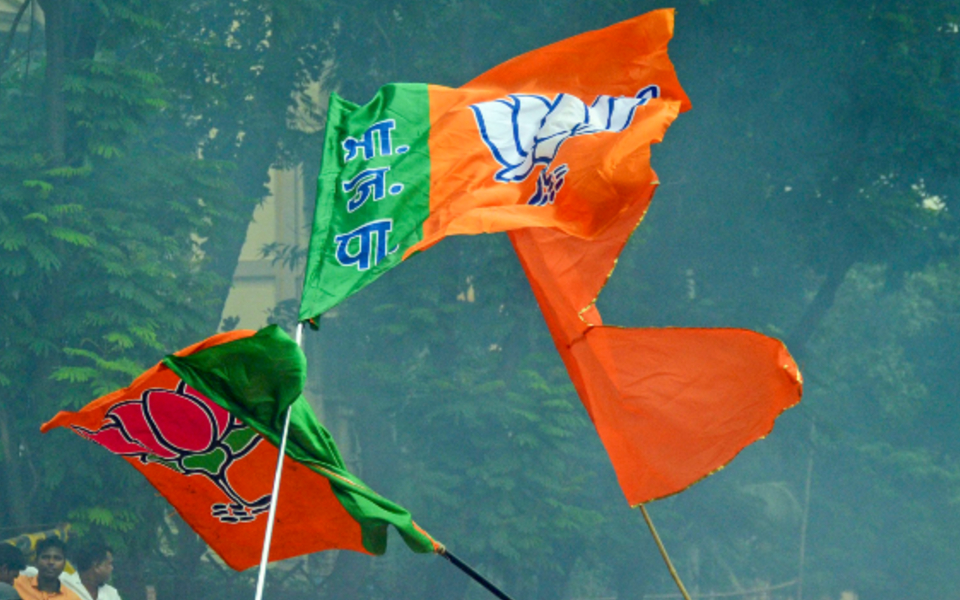
Sangh blooms in Trinamool backyard, yet BJP left with little ground
The contrasting growth trajectory of the two outfits from the Sangh parivar is largely because Mamata Banerjee’s Trinamool Congress while going all out to fight BJP politically is taking a soft approach towards the RSS and its Hindutva ideology.

Just a couple of days after Vijayadashami celebration, the sprawling playground of a West Bengal government-run school in Nadia district turned into an RSS training workshop.
Around 150 youths assembled for the training at the district’s Tahepur Netaji High School, eager to join the ideological fountainhead of the country’s ruling party, the BJP.
Every year in between Vijayadashami (Dussehra) and Diwali, the Rashtriya Swayamsevak Sangh (RSS) organises such primary-level induction training programmes across the country.
Apart from imparting lessons on its ideology, the potential recruits are given basic training on self-defense and yoga during the brief programme, generally lasting around seven days.
This year, an RSS functionary says, there has been an overwhelming participation in around 50 camps they conducted in West Bengal.
The response is not surprising considering that the organisational progress report the Bengal unit submitted in the Sangh’s just concluded executive meeting at Uttar Pradesh’s Prayagraj showed around 25 per cent growth in the number of its branches (shakhas) in the state in the past one year.
During the period, the RSS has added over 470 new shakhas to its existing 1900 branches in the state, sources in the Sangh said.
“The growth story of the Hindutva ecosystem will surely keep the BJP’s electoral hope alive in the state despite a gradual decline in its vote share since the peak of 2019 parliamentary elections,” said political commentator Ranjan Sengupta.
It had then grabbed 18 seats with a vote share of a whopping 40.7 per cent. The party’s vote share slipped to 37.97 per cent in the 2021 assembly elections.
The slide continued in the subsequent civic body elections and by-polls for Ballygunge assembly and Asansol Lok Sabha constituencies earlier this year.
In the elections to the 226 wards in four municipal corporations of Siliguri, Asansol, Bidhannagar and Chandernagore held in February, the BJP votes dropped by around 24 per cent from what it had got in these areas during assembly polls eight months ago.
Similarly, in Kolkata’s Ballygunge, the saffron party’s vote share declined to 12.8 per cent from 20.50 per cent it secured in the assembly elections.
In Asansol, the parliamentary seat the party had won back-to-back in 2014 and 2019, the vote share eroded to 30 per cent from the high of 51.16 per cent the BJP secured in 2019 Lok Sabha elections.
Mamata’s affiliations
The contrasting growth trajectory of the two outfits from the Sangh parivar is largely because Mamata Banerjee’s Trinamool Congress while going all out to fight BJP politically is taking a soft approach towards the RSS and its Hindutva ideology.
Banerjee’s relation with the RSS is always a topic of political speculation in the state ever since she had sought its support in 2003 to fight the then Communist government in the state.
Appreciating her fight against the alleged “red terror”, RSS leader Tarun Vijay once called her “Bengal ki Durga.” Another Sangh ideologue and a former BJP parliamentarian Balbir Punj had also hailed the TMC supremo as “sakshaat Durga.”
Her party was also part of the BJP-led NDA government headed by Atal Bihari Vajpayee.
Different yardsticks
The speculation got a fresh momentum when Banerjee sought to differentiate between the RSS and the BJP last month. “All in the RSS are not bad. There are many who do not support the BJP,” she claimed, clearly applying two yardsticks for Hindutva ideology and Hindutva politics, though not many will be able to discern one from the other.
The ruling TMC’s soft-pedaling of the RSS was further evident from the fact that many state-government run schools allowed their premises to be used for the training programme of the Hindutva outfit.
Only after objections from Bengal Teachers and Employees Association and other forums that some camps, including the one at Tahepur Netaji High School, were either suspended or shifted elsewhere.
“To fight an ideology, you have to have a counter ideology. But the TMC unfortunately does not have any ideology of its own and so it does not feel that strongly the need to fight the Sangh ideologically though it is fighting the BJP politically,” said Amitava Chatterjee, a senior leader of the Socialist Unity Centre of India (SUCI), once an ally of the TMC.
The Left ideology got discredited due to the “misrule of the CPI (M)-led left Front government,” which had ruled the state for 34 years in a trot until dethroned by TMC in 2011, he argued.
“Since the Left ideology has become discredited and the TMC does not have any ideology, an ideological vacuum has been created in the state. The RSS is taking advantage of it,” Chatterjee added.
Chatterjee’s hypothesis is validated by the fact that ever since the TMC came to power, the number of RSS shakhas grew by over three fold. In 2011, there were only about 580 shakhas in the state as against around 2370 now.
The alleged spurt in Muslim population in the state, one-sided narrative of Hindu victimhood during the partition of Bengal, purported neglect of tribals and Dalits and conversion of Adivasis into Christianity allegedly through enticement are some of the common refrains the RSS is using to spread its wings.
“Unless the growth of the RSS is stemmed and reversed by refuting its narratives, the BJP’s recent political setback will just be a temporary phase,” Sengupta added.

